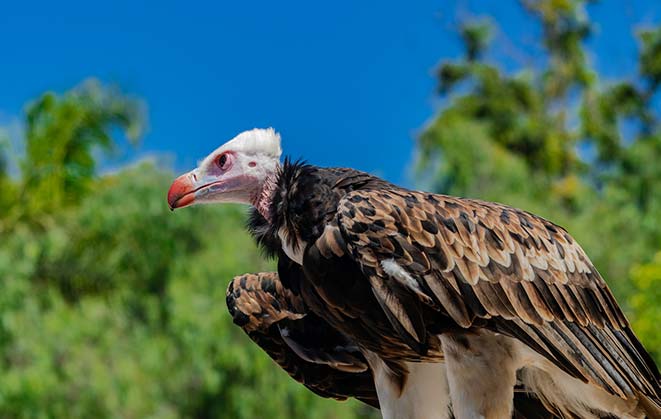White-headed Vulture (Trigonoceps occipitalis)
The White-headed Vulture is an Old World Vulture and monotypical to the Trigonoceps genus. Depending on the author this vulture is also classified as Aegypius occipitalis thereby acknowledging its relationship to the Monk Vulture.
As such, the White-headed Vulture is a native to African continent where it is distributed over vast areas but still scarce to uncommon. Its habitats are savannah, thornbush and lightly wooded grassland; it likes to forage in open country and semi-desert.
The White-headed Vulture is kept in European zoos and falconries for breeding programmes.

Description - Characteristics: (African) White-headed Vulture
Breeding – Clutch – Measurements – Habitat – Diet - Threats
Taxonomy:
Order: Accipitriformes
Family: Accipitridae
Genus: Trigonoceps
Species: White-headedd Vulture
Scientific Name: Trigonoceps occipitalis
Names and Synomys of the White-headed Vulture
Name in German: Wollkopfgeier
Name in French: Vautour à tête blanche
Name in Dutch: Witkopgier
Name in Spanish: Buitre Cabeciblanco
Name in Italian: Aavviltoio testabianca
Name in Finnish: Kirjokorppikotka
Name in Danish: Hvidhovedet Grib
Name in Swedish: Vithuvad gam
Name in Polish: Sęp białogłowy
Name in Russian: Африканский белогорлый гриф
Name in Afrikaans: Witkopaasvoël
Name in Swahili: Tumbusi Kichwa-cheupe
Description of the White-headed Vulture
Distribution: Afrotropical. Endemic to sub-saharan Africa: Senegal, Gambia, Guinea-Bisseau, from southern Mali, Upper Volta, northern Ivory Coast eastwards to southern Sudan, Ethiopia, western Somalia, south through East Africa to Zimbabwe, southern Angola, northern Namibia, Botswana, eastern parts of South Africa and Swaziland.
Movements: Mostly nomadic movements from immatures.
Habitat: Savannah, thornbush, lightly wooded grassland, forages also on open countryside and semi-desert areas; sea-levels of up to 4,000 m.
Behaviour: Solitary, breeding als single pair. No more than 8 individuals at carcases. Search flights to detect useful carcases. After detecting a carcas the vulture glides down and firstly perches on next tree. White-headed Vultures love to feed on carcases without any company of other vultures. When feeding they take a chunk off the carcass and than walk to the side to consume.
Measurements
Size: 72-82 cm
Tail: 27-30 cm
Weight: 3,300-5,300 g
Wingspan: 207-223 cm
Wing:
♂: 582 mm
♀: 600-612 mm
Voice: mostly silent, utters squeaks, hisses and grunts..
Breeding
Sexually mature: Probably not before 3rd to 4th year.
Mating: Monogamous breeding pair, lifelong pair; mating coincides with nest building.
Clutches per breeding season1 clutch
Breeding: depends on geographical region, in general December to September, mostly February to March: Sudan from November to December, Somalia from Oktober, Kenya from July, Tanzania (Usambara-mountains) from June, Zimbabwe from August, South Africa from May.
Nest: Mostly large platform made from sticks measuring 80-170 cm across and 20-60 cm deep. Often conspicuously in crown of high trees. Lined with grass. Colonial, nest in the top of thorny trees but also in steep cliffs.
Neststandort: der Wollkopfgeier brütet nicht in Kolonien. Seinen Horst errichtet er auf dornigen Bäumen und dort in der Wipfelregion. In felsigen Gegenden werden Horste auch in den Nischen von Steilwänden angelegt.
Clutch: 1 egg
Egg: elliptical whit egg and brown staints.
Egg Measurements and Weights
Length x Width: 82.0x65.0 mm
Weight: ≈ ??? g
Recurrent clutches: no data recorded.
Incubation: ≃ 43-54 Tage, both parents share the task of incubating.
Fledging: Chicken is fed by both parents. Fledging after c. 110-120 days.
Dependency: Most probably the young White-headed Vulture is cared for by the parents for a longer period; though, there are no firm data available.
Voice: mostly silent, utters squeaks, hisses and grunts..
Breeding
Sexually mature: Probably not before 3rd to 4th yearwahrscheinlich nicht vor dem 3.-4. Jahr, lebenslange monogame Verbindung.
Mating: Monogamous breeding pair, lifelong pair; mating coincides with nest building.
Clutches per breeding season1 clutch
Breeding: depends on geographical region, in general December to September, mostly February to March: Sudan from November to December, Somalia from Oktober, Kenya from July, Tanzania (Usambara-mountains) from June, Zimbabwe from August, South Africa from May.
Nest: Initially small platform made from sticks, 40-65 cm across and only 15 cm deep. After several years of use, the platforms extends to 1.5 m across and 1.2 m deep. Lined with grass. Colonial, nest in the top of thorny trees but also in steep cliffs.
Neststandort: der Wollkopfgeier brütet nicht in Kolonien. Seinen Horst errichtet er auf dornigen Bäumen und dort in der Wipfelregion. In felsigen Gegenden werden Horste auch in den Nischen von Steilwänden angelegt.
Clutch: 1 egg
Egg: elliptical whit egg and brown staints.
Egg Measurements and Weights
Length x Width: 82.0x65.0 mm
Weight: ≈ ??? g
Recurrent clutches: no data recorded.
Incubation: ≃ 43-54 Tage, both parents share the task of incubating.
Fledging: Chicken is fed by both parents. Fledging after c. 115 days.
Dependency: Most probably the young White-headed Vulture is cared for by the parents for a longer period; though, there are no firm data available.
Miscellaneous
Food: The White-headed Vultures mainly depends on the abundance of mostly large carcases. Also lifes of freshly cut Flamingos, small mammals, lizzards, dead fish being washed up; termites, locusts if available. From carcases everything is processed except for the skin.
Longevity: unknown.
Mortality: unknown.
Threats: Loss of habitat because of changes introduced in how agricultural and forestal areas are being managed. Targeted poisoning by laying out poisoned carcases.
References
Bauer, Hans-Günther, Bezzel, Einhard et. al. (HG), Kompendium der Vögel Mitteleuropas, Band 1+2, Sonderausgabe 2012, Aula Verlag, Wiebelsheim
Bauer, Hans-Günther, Bezzel, Einhard et. al. (HG), Kompendium der Vögel Mitteleuropas, Band 3, Literatur und Anhang, Aula Verlag Wiebelsheim, 2. vollständig überarbeitete Auflage 1993
Baumgart, Wolfgang, Europas Geier, Flugriesen im Aufwind, AULA-Verlag Wiebelsheim, 2001
Bezzel, Einhard, Kompendium der Vögel Mitteleuropas, Non-Passeriformes, Band 1, AULA-Verlag Wiesbaden, 1985
Ferguson-Lees, James and Christie, David A., Raptors of the World, Houghton Mifflin Company Boston New York, 2001
External Links
Image Credits
White-headed Vulture - source: Martin Leber/agency iStock
